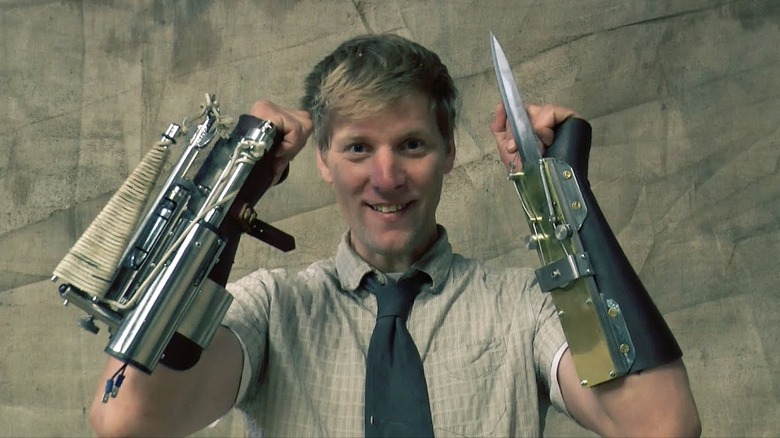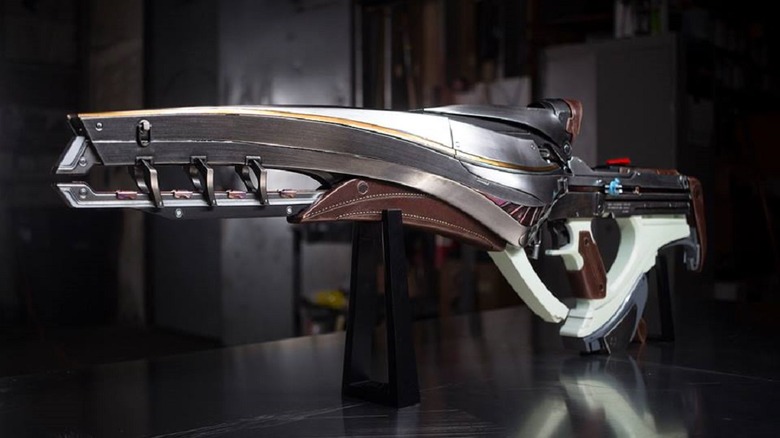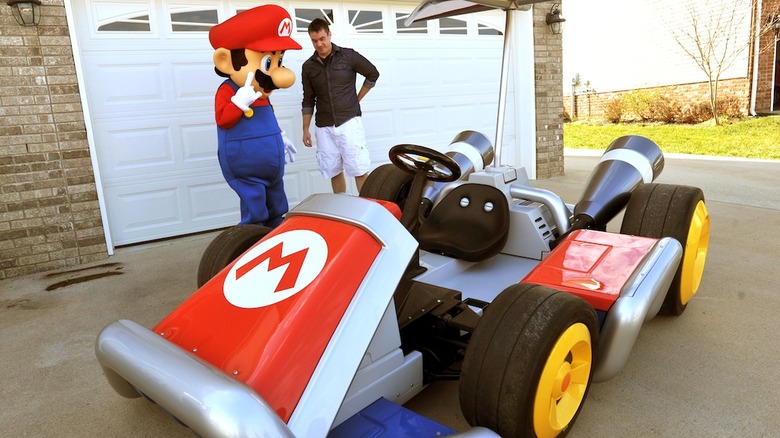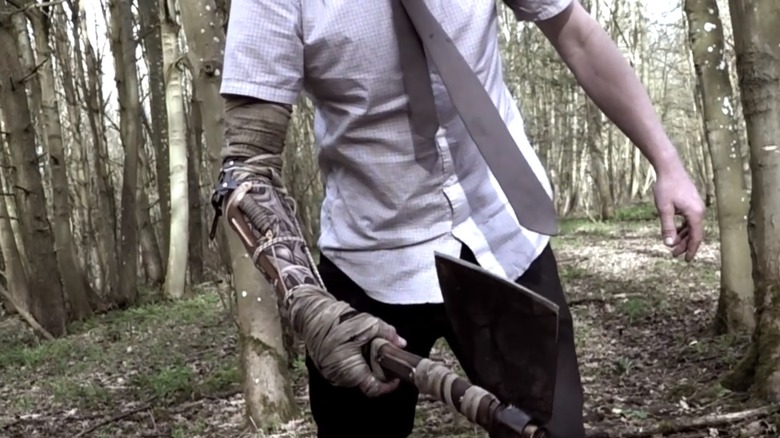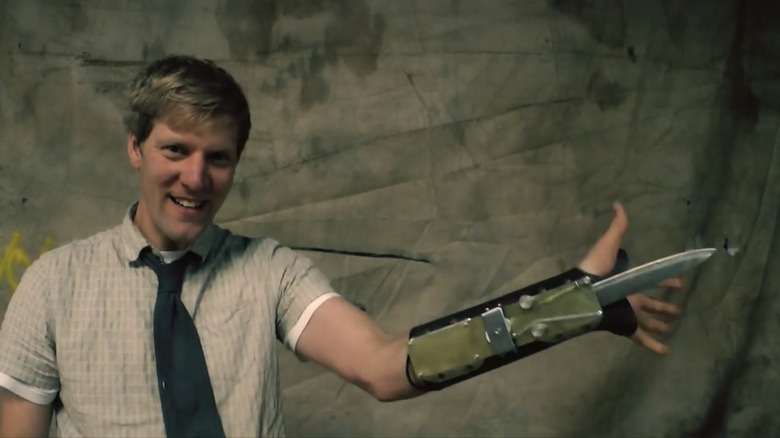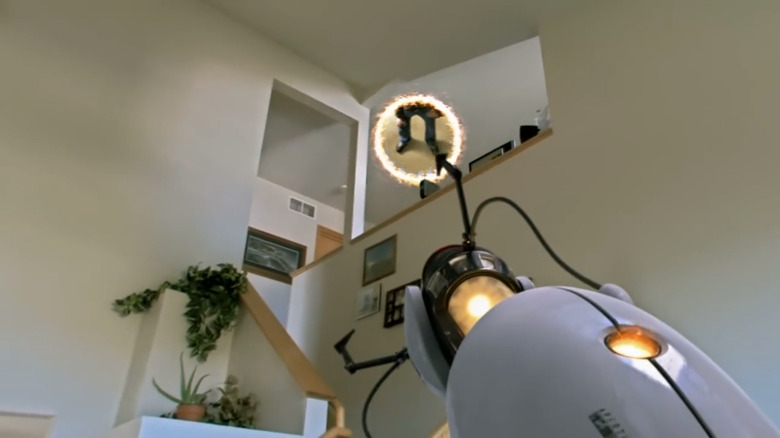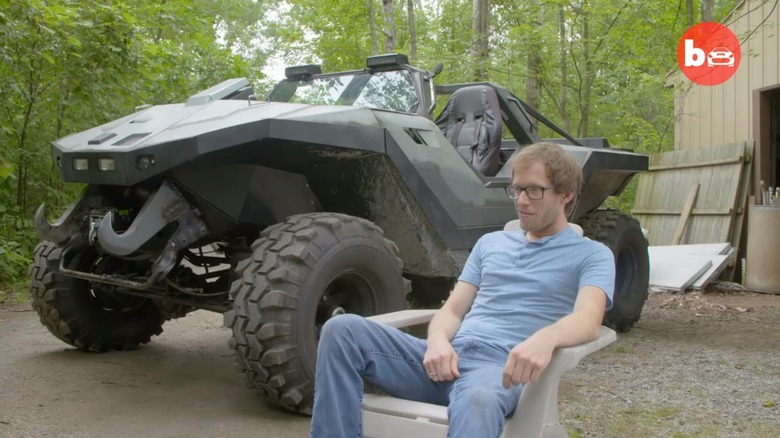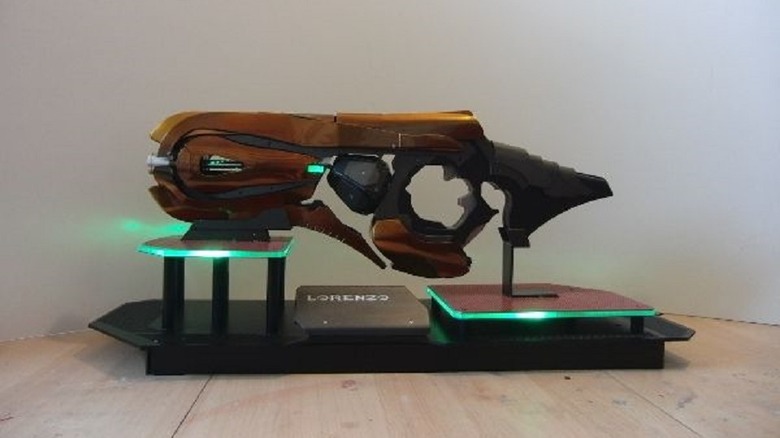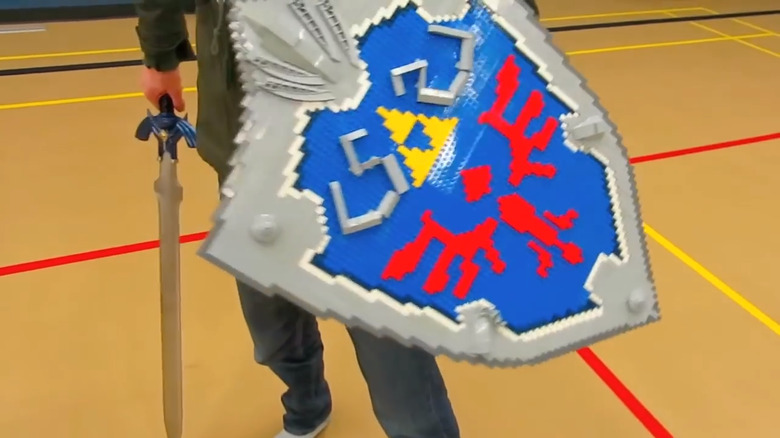Amazing Real Life Creations Inspired By Games
You know you love a video game when you're willing to bring a piece of it into the real world. It's something we see a lot of today, with the popularity of cosplay and the plethora of game conferences that invite players to show off their own creations. It didn't always used to be this way; remember when video games were for nerds, and admitting that you played them got you labeled as some sort of basement-dwelling dweeb?
Fast forward to today, and legendary designers like Shigeru Miyamoto and Hideo Kojima have to take selfies with fans every five minutes. And some of those fans are famous themselves.
The truth is, video games aren't just for the outcasts. They're as much an artistic medium as film or music. And those mediums inspire fans to make things themselves. In the world of film, someone might see a great movie and decide to dress up as their favorite character for Halloween, or for a convention. With music, a beloved song might drive someone to create their own remix, adding their own spin to the original work. And with video games, someone might find a weapon or a vehicle that really captures their heart. And from there, they'll try to recreate it as best they can.
Below, we've compiled a list of some of the coolest creations we've encountered, ripped right out of video games and into the real world. Maybe they'll inspire you, too.
Deacon's bike from Days Gone
If you've played Days Gone, you either love Deacon's motorcycle or you absolutely hate it. On one hand, it provides a quick way to travel long distances in a short amount of time. That's good! The swath of Oregon represented in the game is huge. On the other hand, though, the game gives you a motorcycle. That means it's going to find a way to make you use it a lot, resulting in a storyline that goes out of its way to crisscross the map and keep you hunting for gas cans.
The team at PlayStation Nordic may be a tiny bit biased, given that Days Gone was a Sony-developed title, but they apparently had a soft spot for Deacon's bike. So much so, in fact, that they assembled a real-life version of the vehicle.
According to the PlayStation Blog, the folks over at Nordic rounded up four Danes to get the job done: a project lead, a motorcycle repair specialist, a designer, and mechanic with metalworking experience. And then PlayStation Nordic put these four experts to work, giving them just 48 hours to sketch out some rough drafts, find suitable parts, and put the whole thing together. As you can see above, the final version of the bike is a pretty convincing replica, and it does Deacon's ride justice. What we don't know, however, is if the thing actually runs. Come on, PlayStation Nordic: take it for a spin.
Destiny 2's Polaris Lance
Destiny 2 has a wealth of cool-looking exotic weapons, lovingly crafted and rendered by the many artists and developers at the studio. And in many cases, the guns are just as fun to look at as they are to use. That's the whole draw to chasing an exotic weapon, really. You want to use it to kill the many bad guys you'll encounter in Destiny 2, but you also want to show it off to your friends, sort of like you would a sports car.
The Polaris Lance replica shown here is on display, as it should be. But the story behind it is far more interesting than someone obtaining the gun inside Destiny 2.
The Polaris Lance first appeared in the Warmind expansion of Destiny 2, which came in the spring of 2018. This was a tumultuous time for Destiny 2, as the main studio behind the game, Bungie, was simultaneously working on fixes for the game while also developing its next big expansion. Vicarious Visions, an Activision-owned development studio, stepped in to pick up the slack, developing the Warmind expansion that many players feel put Destiny 2 back on the right track. And as a thank you, Bungie had a replica of that expansion's new exotic, the Polaris Lance, made and delivered to Vicarious Visions in New York.
Bungie and Activision have since separated, which means Vicarious Visions is likely done doing work for the Destiny franchise. But this replica will always remind them of the stellar job they did.
Mario's Kart
Who doesn't love Mario Kart? It's the perfect pick-up-and-play game, with easy-to-learn controls and hard-to-master strategies. Many a boring night has been saved by booting up Mario Kart and playing well into the early morning hours, and now that the Nintendo Switch has a version of the game, you can be flying across the country and still feel like you're playing a console version of Nintendo's popular racer.
In fact, the only thing that might be better than playing Mario Kart on your Nintendo console of choice is actually driving Mario's Kart. Which is what one lucky Nintendo fan got to do, thanks to a contest held by GameStop back in 2012.
Nathanial Stehley, who got lucky thanks to the GameStop rewards program, managed to win himself a full-sized go kart that bears more than a passing resemblance to Mario's own ride from Mario Kart. And the vehicle was delivered with a team from Nintendo in tow, offering him a comically oversized key for the kart along with a congratulations from Mario himself. In the present day, we have to wonder what ever came of this kart. Did Stehley keep it? Did he sell it on eBay to some other Nintendo fan? Did he get it destroyed in a head-on collision with a turtle shell? Whatever the case, we appreciate that this homage to Mario Kart existed at one point, and if you can fill us on the kart's current whereabouts, please get in touch.
Sekiro's Shinobi Prosthetics brought to life
It didn't take long for Sekrio: Shadows Die Twice to amass a legion of fans; but then again, Sekiro is no ordinary game. It's developed by FromSoftware, a studio that has won a devoted following due to its time working on the Dark Souls series, along with creating Bloodborne on the PlayStation 4. And really, the tools available to you in Sekiro are so fun to use that they help the game stand out from other action games on the market.
That's why a man named Colin Furze went to great lengths to assemble real-world versions of a few. And on YouTube, he shows them off in action in a way that might make you insanely jealous.
The Shinobi Prosthetic in Sekiro is highly versatile, as its many attachments can come in the form of weapons or defensive tools. And Furze has built a few of them. There's the Axe of the Monkey for instance, which Furze managed to convert into a wrist-mounted axe that can do a number on flying melons. And Furze also put together an Iron Fortress, an add-on that instantly fans out into a metal shield. It's an impressive bit of handiwork from someone who is clearly skilled in building all sorts of things.
And Sekiro isn't the only game Furze has honored with his creations.
Assassin's Creed's hidden blade and grappling hook
Let's all be honest with ourselves: we've all seen gadgets in video games that we wish we could use in real life. It took us decades to get anything close to the smart watch from GoldenEye. The cloaking armor in games like Halo and Titanfall is still a pipe dream. And who wouldn't want a Batmobile?
We can't say that we've ever wanted to use the hidden blade from Assassin's Creed; we're not killers, after all. But we have definitely wanted access to an automatic grappling hook for, you know, purposes. And Colin Furze, who worked on all those cool Shinobi Prosthetics from Sekiro, built both of those Assassin's Creed items, too.
As you can see, the hidden blade doesn't work quite as seamlessly as it does in the Assassin's Creed series. It doesn't manage to flick itself out magically but, instead, requires a bit of coaxing via a cord that's attached to a ring worn by the wearer. And as far as the grappling hook is concerned, it doesn't reel Furze in quite at the speed it does in games like Assassin's Creed: Syndicate, but that's more a limit of the technology available in the real world than it is a knock on Furze's construction skills.
Still, these are pretty sensational builds. And we can rest assured that, as soon as another game comes out with a cool gadget, Colin Furze will likely try to make it.
A Portal Gun that, sadly, doesn't actually work
There are a lot of questions we still have about Valve's Portal Gun from the Portal series. For instance, can the portals ever be out of range from one another? What happens to the bits of the floor or the wall that were present before a portal took its place? And how exactly do you charge a Portal Gun? Do you just plug it in like a smartphone, or is there some kind of special charging mechanism that allows the gun to charge itself?
We should probably thank our lucky stars that these guns don't actually exist; the potential for abuse is very real. But that didn't stop Jason Craft from making his own Portal Gun and at least imagining what it might be like to use one.
Real props have to be given to the Portal Gun itself, as it looks like it was ripped right out of the video game. But we have to commend Craft for his video production skills, too, as he does what most of us would do in a heartbeat if we had access to a real Portal Gun: he trolls his friends. The highlight comes when one friend, who spends a not-insignificant amount of time in an endless loop between two portals, gets shot out from the side of Craft's home, eventually crashing into the backyard fence.
We'd never do that to one of our friends. Right guys? Right?
The Halo Warthog
There are fans, and there are mega-fans. There are those who say, "Oh, I'd definitely make myself a Warthog if I had a million dollars." And then there are people who pour their discretionary income into building a Warthog anyway, buying the parts and forging the epic Halo vehicle with their own bare hands.
That's what Bryant Havercamp did. The Michigan-based phone technician was a huge fan of the Halo series, and decided he'd take a stab at building his own Warthog, pouring thousands of dollars into building a life-size replica that, believe it or not, is street legal.
According to Havercamp, the Warhog he created is built on the frame of a 1984 Chevy K10 truck. He pulled the model for the Warhog directly out of Halo and went to work modeling the necessary parts, in some instances fabricating them himself. He acquired an engine from a Chevy 360 and rebuilt it for his new machine. And he used a 3D printer to craft some of the tinier parts that couldn't be purchased anywhere else.
All in all, the project ran Havercamp somewhere between $10,000 and $11,000 dollars. That's actually not too shabby for a fully functional Warthog, not counting all the hours of labor. But the cost had to be worth it to finally live the dream of driving a real Warthog. Hats off, Bryant.
Sweet Tooth's Twisted Metal ice cream truck
David Jaffe is nothing if not a character. He's well known, of course, for working on the Twisted Metal series, as well as serving as the game director for the original God of War and, later, as the creative director for God of War 2. But he's renowned for having a sense of humor, and in fact, has a Twitch channel he now devotes to all sorts of random things.
Back in 2012, however, Jaffe was still very much involved in the video games industry. He was working on a reboot of the Twisted Metal franchise, which was scheduled to arrive later that year. And in order to promote the upcoming title, Jaffe went above and beyond what most video games do for advertising.
Jaffe and his team at Eat Sleep Play created a real-world version of Sweet Tooth's ice cream truck, complete with an enormous clown head on top and a beat-up exterior. And at that point, most studios would've stopped and said, "Hey, let's drive this thing around to some events and let fans take pictures with it." David Jaffe, however, had a different idea. He drove the ice cream truck into the desert, parked it in a secluded spot, and rigged up a computer connected to an M249-SAW machine gun.
And then he posted a video inviting Twisted Metal fans to visit a website that would enable them to shoot the living daylights out of the truck. Because he's David Jaffe. Of course he did.
A Halo Plasma Repeater that shoots real lasers
Up to this point in the list, we've seen a replica gun or two. And usually, what's implied by using the term 'replica' is that the item in question isn't the real thing. When you buy a replica jersey, for instance, it's not the same jersey someone would wear onto the field. It's just made to look like one. That's the idea with replica weapons from video games. Do they look like the real thing? Yes. Do they operate like the real thing? Usually, no.
Patrick Priebe doesn't mess around, though. If he's going to build a gun, he wants it to operate in a realistic way. Which means that creating a Plasma Repeater from Halo requires that the weapon at least shoot a real laser out of it. So it does.
And don't mistake these lasers for the kind you might find in a laser pointer. You won't be giving presentations with these bad boys. If you point Priebe's Plasma Repeater at a whiteboard and attempt to point out the dip in revenue from quarter one to quarter two of the fiscal year, you'll wind up putting a hole in it. As a result, the hobby is quite an expensive one, and is rather time consuming, too.
"One bad touch can kill [the laser] and hundreds of dollars are gone with the wind," Priebe told Dot Esports, adding that the Halo Plasma Repeater "took half a year, including designing parts."
Wow.
Link's Hylian Shield, constructed entirely out of Lego
In some households, Lego pieces are as controversial as Game of Thrones Season 8. Are they the enablers of creativity, driving anyone with an imagination to build something spectacular? Are they a metaphor for how insignificant we are alone, yet how powerful we can be as a whole? Or are they nuisances that are lost until they're found on the underside of your foot or in the bowels of the family pet?
Regardless of how you feel about Lego, it's tough to argue that people aren't building some really cool things using the insane amount of kits out there. With all of the pieces available, you can make just about anything. And YouTuber ZaziNombies proved it by creating a life-size replica of Link's Hylian Shield from The Legend of Zelda using nothing but Lego.
In his YouTube video, ZaziNombies goes through some of the decisions he made and some of the more abstract parts he used to get the Hylian Shield looking exactly right. And we have to admit, we love how the use of Lego gives the shield a decidedly pixel-art look. All that's missing is a ... OH, he made a Master Sword, too?! Well played, ZaziNombies. Well played.
An OutRun arcade cabinet turned into a legit vehicle
This last one might blow your brain a little bit, because what Dr. Garnet Hertz built is so entirely outlandish that you might wonder why in the world anyone would do such a thing. But we promise you, there's a twist coming. Let's start with the doctor.
As Car and Driver tells it, Dr. Hertz happened upon someone selling an OutRun arcade cabinet back in 2006, and spent a total of $1,100 to have the cabinet shipped to his home. From there, Dr. Hertz acquired a three-wheeled golf cart (thanks to support from UC Irvine's Center for Computer Games & Virtual Worlds) and conjured up a sort of augmented reality machine with the help of his students. It plays OutRun while showing the real world in the background, and it actually moves. It's a one-of-a-kind experiment, and surely something we'd never see again, right?
Enter Ryo Hazuki, the star of the '80s-centric video game Shenmue.
When Ryo Hazuki made his debut on the iOS and Android versions of Sonic & All-Stars Racing Transformed, he didn't bring his legendary forklift from past Sonic racers. Instead, he drove vehicles based on a number of '80s arcade machines. And wouldn't you know it: one of Ryo's vehicles is a rolling OutRun cabinet that looks exactly like the machine Dr. Garnet Hertz built years earlier.
Was Ryo's ride inspired by Dr. Hertz's work? Or is this coincidence? We aren't sure, but we'd love to know.

